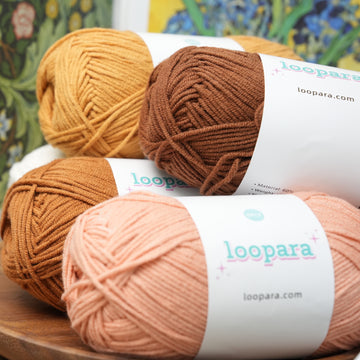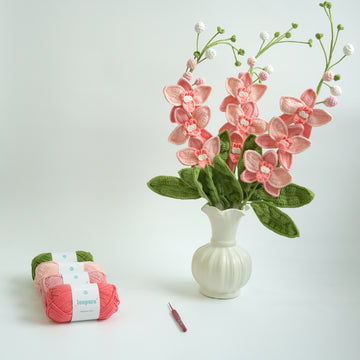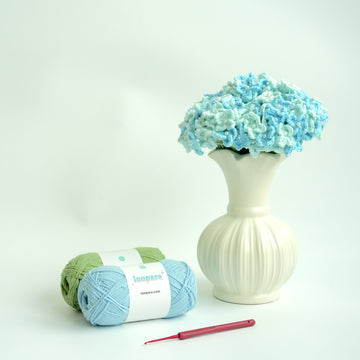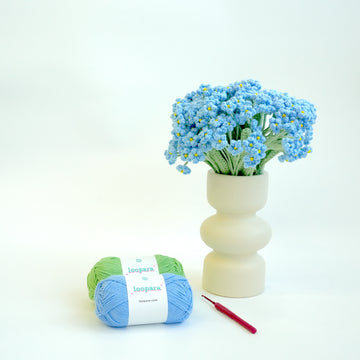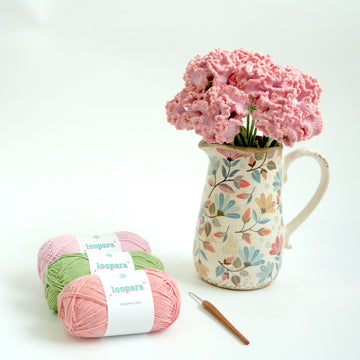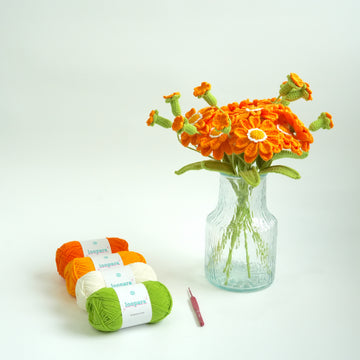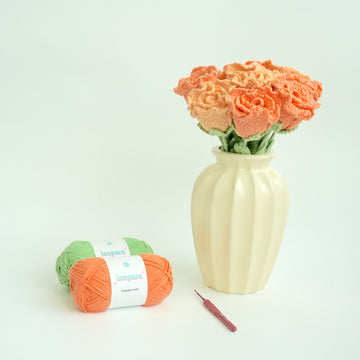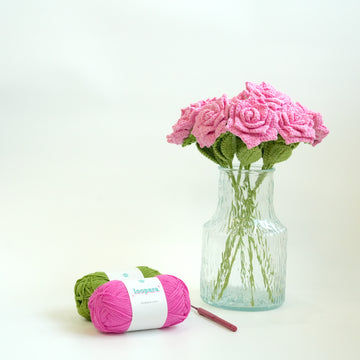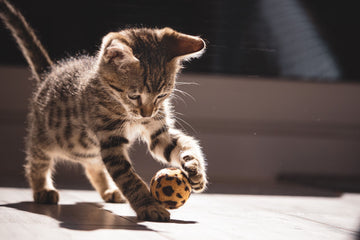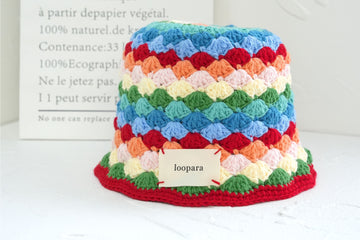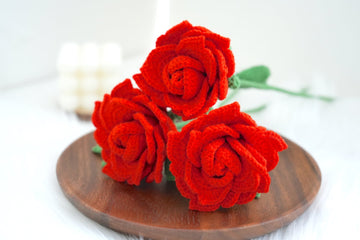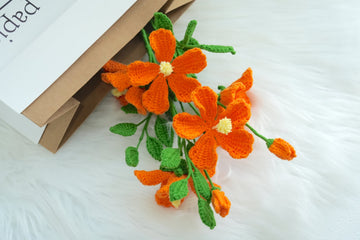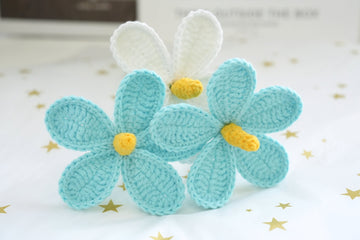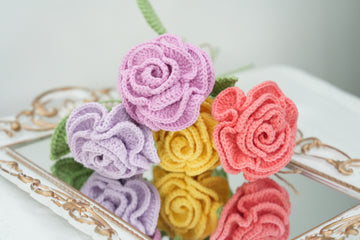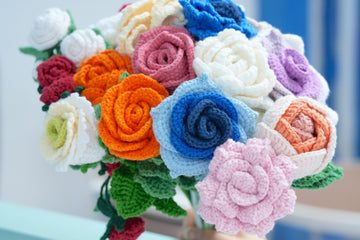If you’re crocheting a scarf, you might want to know it will be ready for the winter weather. But just how long does it take to crochet a scarf?
Exactly how long it will take depends on a number of different factors. But we’ll share some ballpark figures to give you an idea. And we’ll explain how to get a better estimate for your specific project.
Ready? Then let's get started.
What affects how long it takes to crochet a scarf
Lots of different factors interact to determine how long your project is going to take. Let’s look at them one by one.
Your level of proficiency
Are you just starting out on your crochet journey, or a seasoned crocheter? It stands to reason that beginners will take longer to complete a scarf.
If you’re new to crocheting, try not to rush. It’s all too easy to go wrong and then have to frog (i.e. unpick) your hard work!
But that’s not to say beginners can’t crochet a scarf in a reasonable amount of time. There are lots of other variables you can tweak to finish your scarf more quickly…
The complexity of the pattern
Patterns that incorporate lots of different stitches and colors will take longer to finish than simpler options.
With a monochrome scarf in a single stitch, you’ll just count your stitches and keep going until the scarf is as long as you want it to be.
For more detailed patterns, though, you may need to use stitch markers. And if your scarf involves different colors, it will take time to change the yarn and weave in more ends.
The size of the scarf
All other things being equal, the bigger the scarf, the longer it will take to make. So if you’re crocheting a scarf for a toddler, you’ll get it done faster than one for an adult.
There are no hard and fast rules about how long or wide a scarf needs to be. As long as it can loop loosely around the recipient’s neck with long enough ends to tuck into a jacket, it’s fine.
Longer scarves give the option of being wound around the neck more times. That’s great for a cosier effect, but it will also be bulkier. If your recipient tucks their scarf neatly inside a jacket, something shorter might work better.
The weight of the yarn
In crochet, yarn weight refers to its thickness. The heavier (i.e. thicker) the yarn, the quicker you’ll be able to work it up into fabric.
Standard yarn weights are divided into eight categories, from 0 to 7. The lower the number, the thinner the yarn.
If you’re creating a light, lacey scarf using a yarn weighted 1 or 2, it will take longer. (As usual, that depends on all the other variables – size, pattern, etc. being the same.) If you want to finish the scarf as quickly as possible, choose a chunkier yarn weighted 5 or above.
The size of the crochet hook
The larger the hook, the looser and more open your crochet stitches will be. That means each stitch will take up more space. And it also means you’ll be able to work up your scarf faster than if you used a smaller hook.
As a general rule, it’s recommended to use a smaller hook for thinner yarns and a larger hook for thicker ones. But you can switch things up to get different effects.
As well as helping you finish your project sooner, a larger hook will give your fabric a lacier look. It will drape more smoothly too.
A smaller hook, on the other hand, will create a denser fabric, great for keeping out the winter chill!

Time to crochet a scarf: ballpark estimates
All these different factors will affect the time taken to make your scarf. But how does that help you calculate how long it will take to complete your project?
One way is to start with a ballpark figure and then adjust it. So here goes…
We’d suggest setting aside 3 to 4 hours to complete a scarf, based on the following:
- An intermediate level of skill – you’re not a beginner, but you’re not a top-level expert either
- A simple pattern – using one or two stitches, three colors or fewer, and changing colors every five to ten rows
- A standard sized scarf for an adult – big enough to loop comfortably around a neck
- A bulky or super bulky yarn – weighted 5 or 6
- A hook size between K and Q – that’s between 10.5 and 13 in UK hook measurements, or between 6.5 mm and 15 mm in metric.
Change any of these variables, and you’ll add or decrease the time requirement.
If you’re a beginner at crochet, you can expect a project like this to take at least eight hours. And don’t be disheartened if it takes even longer – you’ll get quicker in time.
A more complex pattern, an extra-long or extra-wide scarf, a thinner yarn or a smaller hook will all mean your scarf takes longer to complete. Conversely, a simpler pattern, jumbo yarn or larger hook will speed things up.
Estimating the time needed to complete your scarf
Starting with the 3 to 4 hour estimate and adjusting it depending on the different variables can give you a rough idea of how long your scarf will take to make. But there’s a snag.
How do you know how much time to add to or take away from that starting estimate?
If you’re an experienced crocheter, you’ll probably know how much difference yarn weight, for example, makes to your speed. But if you’re not, it’s going to be more difficult.
The good news is, there is a way you can come up with a more robust estimate. And it will help you get a better idea of how your finished scarf will look into the bargain.
To do that, you need a gauge swatch. That’s a small piece of the fabric your scarf will be made from. By checking how long it takes you to make, you’ll be able to get a better estimate of the time requirement for your project.
Making a gauge swatch
Gauge swatches usually measure 4 inches wide by 4 inches long. The idea is that this is big enough for any variations in the tension as you work to average out.
If you’re making a scarf with a complex pattern, make your gauge swatch bigger to incorporate the whole pattern repeat.
Use the same yarn and hook size you’re going to use for your scarf. Then set a timer and get to work on your swatch. Note how long it takes you to complete it.
If you want to adjust your tension, yarn or hook size to get a different effect, now’s the time. Change what you want to and make another swatch. As before, set the timer before you start, and note how long it takes you to finish.
Using your gauge swatch to estimate project time
When you’ve got a swatch you’re happy with, you’ll need to do some simple math.
Step 1
Divide the width you want your scarf to be by the width of the swatch. For example, if you want your scarf to be 12 inches wide, and your swatch is 4 inches wide, this is the sum:12 / 4 = 3
Step 2
Multiply the answer in step 1 by the length of time it took you to make the swatch. Let’s stick with the dimensions above, and say it took you 10 minutes to make your swatch. Your calculation would be:3 x 10 = 30 minutes
That tells you it will take you about half an hour to crochet a piece of fabric that’s as wide as your scarf, and as long as the swatch.
Step 3
Now divide the length you want your scarf to be by the length of the swatch. If you want your scarf to be 5 feet long, and your swatch is 4 inches long, the sum would be:5 x 12 = 60 (the required length of your scarf in inches)
60 / 4 = 15
Step 4
Multiply the answer in step three by the time you calculated in step 2:
15 x 30 = 450 minutes
450 minutes / 60 = 7.5 hours – the total time to crochet your scarf.
You now have a pretty good idea of how long it will take you to crochet your scarf. Remember that, in addition to this, you’ll need time to:
- Sew in the ends – remember, there’ll be more of these if you’re changing yarns
- Adding any extra embellishments you want – e.g. fringing, tassels or sequins
- Blocking – you don’t have to block your work, but it will give it a nice, professional finish. That’s particularly good if your scarf is going to be a gift.
Summary: How long does it take to crochet a scarf?
There are lots of factors that determine how long it takes to crochet a scarf.
If you’re a reasonably proficient crocheter making an adult’s scarf and using a chunky yarn, you can expect it to take about four hours. But skill level, pattern complexity, yarn weight and hook size can all make big differences to that time.
If you want to get a better estimate before you start, making a gauge swatch can help. Just remember to use the same pattern, yarn and hook as you’ll be using for the finished item.


